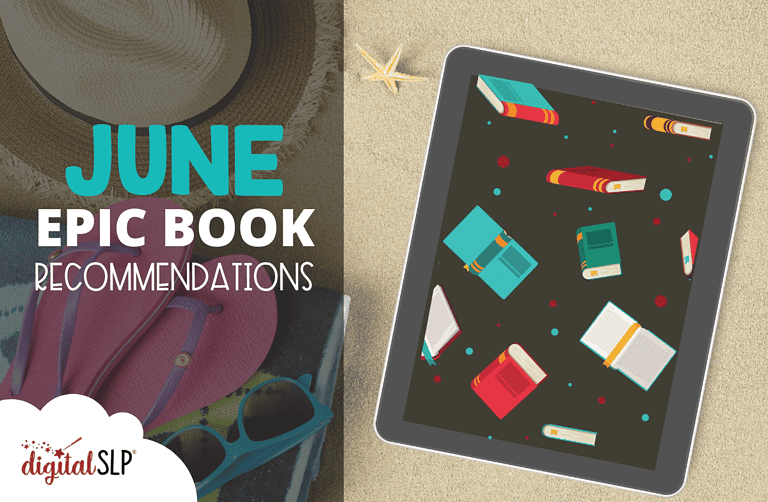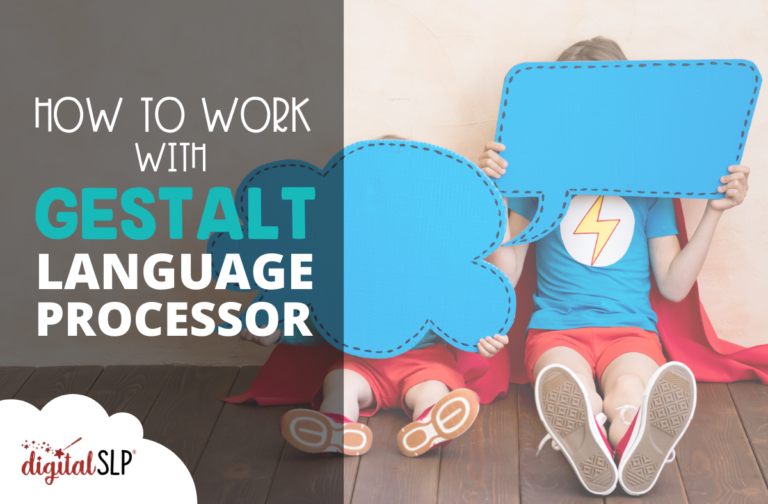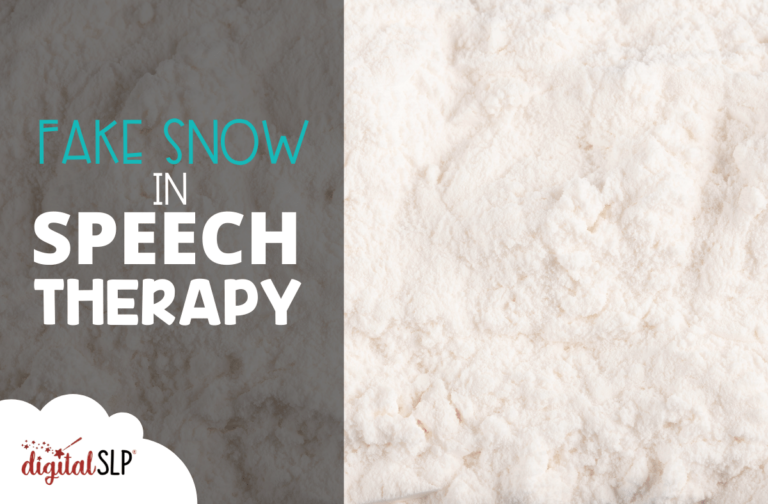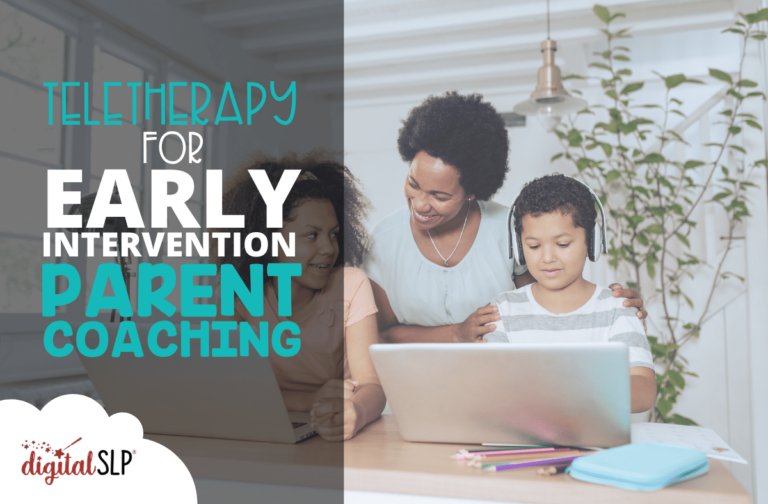This post contains affiliate links for which we may receive compensation at no additional cost to you. Click here to read our full affiliate policy.
Summer is coming! Recently I was daydreaming about a tropical island getaway, and my SLP brain wondered: what if I were stranded on an island (and my whole caseload was there too, and I had to do all my sessions)? What SLP materials I’d want if I were stranded on an island? In other words, what are my go-to resources that can be used with any student? It was a fun thought exercise! I narrowed it down to four favorites—and all of them are accessible, affordable, and available in both digital and print versions.
- Picture Books:
I can’t think of a speech therapy tool more essential than picture books. We can get physical books from the library and digital books through resources like Epic and Vooks. (I love digital books so much, I even recorded two podcast episodes about them—check them out here and here!)
Picture books can be used to address almost any skill. Here are a few of my favorite ideas:
- Articulation: Targeting articulation within storybook reading allows us to work on speech sounds in a meaningful context. We can also bring in literacy and phonological awareness.
- Getting started: The University of Northern Iowa has an incredible online list of picture books sorted by sound.
- Pro tip: Reading picture books to students can be a great way to provide modeling and auditory bombardment.
- Digital SLP resource: Chipmunk Visits the Ranch (sound-loaded story)
- Grammar: Picture books are powerful tools for teaching morphology and syntax! Research suggests that this contextualized intervention is more effective than decontextualized intervention (e.g., worksheets).
- Getting started: Try using books that have many examples of the target structure—bonus points for predictable text! For example, with regular past tense verbs, you could use There Was a Cold Lady Who Swallowed Some Snow, which includes verbs like “swallowed,” “gobbled,” and “tingled,” and follows a predictable structure.
- Pro tip: In their 2006 textbook chapter, Gillam & Ukrainetz suggest adopting a “whole-part-whole” framework when using books to teach grammar. This involves reading and discussing the story (whole), doing focused activities related to the target intervention areas (part), and then creating a parallel story based on the original book (whole).
- Digital SLP resource: There was a Cold Lady Who Swallowed Some Snow book companion
- Vocabulary: Books are a rich source of Tier II vocabulary words that students might not hear in their daily conversations. Also, when students find unfamiliar words in picture books, they can use context clues, make inferences, and analyze illustrations to determine word meanings.
- Getting started: Try modeling a think-aloud for your students. Read through a picture book, pause when you come across an “unfamiliar” word, and speak your thought process out loud (e.g., “I’m not sure what this means, but I see___ in the picture, so I think ___”).
- Pro tip: Digital libraries like Epic often have a dictionary function students can use to look up new words.
- Digital SLP resource: Prefixes Web Activity
- Picture Scenes:
Like picture books, picture scenes are versatile—possibly even more flexible than books, because they are welcoming for non-readers. Picture scenes can also be appropriate for preschool through high school, depending on the selected images. Perhaps best of all, picture scenes are accessible—sometimes all it takes is a quick Google image search!
Here are a few of the ways I like to use picture scenes in speech therapy:
- Describing: Picture scenes provide an engaging introduction to working on describing skills (especially if you choose silly scenes that make students giggle). Describing also links well to other targets, including basic concepts, prepositions, verbs, and emotions.
- Getting started: Picture books can be used as picture scenes—you don’t have to read the words as written! Just choose one of your favorites, ignore the text, and you have a picture scene.
- Pro tip: Challenge your students with a barrier task! In this activity, one student has a picture scene and describes what they see, while another student draws their version of what they hear.
- Digital SLP resource: One Picture, Multiple Goals
- Inferences: With inferences, we use the information we do have to better understand the information we don’t have. This is a challenging skill, and when it includes language demands as well, it can become overwhelming. Picture scenes to the rescue!
- Getting started: I love What’s Going On in This Picture from The New York Times. It involves a compelling photo with the caption removed, so students can make inferences about what they see, and compare their response with “the reveal,” which shares details about the photo. The New York Times even offers an on-demand webinar with details about maximizing this wonderful resource.
- Pro tip: Picture scenes are fantastic for working with mixed groups—I even recorded a podcast episode about this!
- Digital SLP resource: Inferencing with Pictures
- Wh-questions (and categories): It’s vital to explicitly teach students how to answer wh-questions. Research indicates that it can be helpful to do this by using questions that have answers visible in the environment—e.g., on a picture.
- Getting started: “What” and “where” questions are usually the first to develop, so they’re a great place to begin.
- Pro tip: Students who struggle to answer questions sometimes have difficulty asking questions. Intriguing picture scenes can capture students’ attention and encourage them to ask genuine questions about what they see.
- Digital SLP resource: What Questions: Volume 1
- Nonfiction Reading Passages:
Nonfiction reading passages help us align with the Common Core State Standards, and save time! They’re also excellent for addressing multiple target areas, including:
- Discussion skills: By using information from nonfiction reading passages to support their arguments, students can practice backing up their claims with evidence. Discussions can also address listening comprehension, describing, and many aspects of social-emotional learning.
- Getting started: Readworks and Newsela are my favorite sources for nonfiction passages. Also, many newspapers offer free subscriptions to educators.
- Pro tip: Whenever possible, choose topics that your students care about. For example, a discussion about homework policies is sure to elicit lively interactions!
- Digital SLP resource: Around the World Middle School Language Series
- Sequencing: If you typically address sequencing skills with story retell activities, why not mix it up and use some “how to” passages and activities instead?
- Getting started: It can be helpful to introduce a “how to” exploration with a YouTube video related to the material students will be reading and the activities they’ll be completing.
- Pro tip: Sequencing pairs well with predicting! At each step in the process, pause to ask students what they think will happen next (and why).
- Digital SLP resource: We have “how to” instructions for a variety of interests, including how to make chocolate chip cookies, ice cream, seashell wind chimes, and popsicles.
- Vocabulary: Just like books, nonfiction passages are a rich source for Tier II vocabulary words!
- Getting started: As students read multiple nonfiction passages, they may start to see some words pop up over and over. Challenge them to notice how the same word can be used in different ways!
- Pro tip: In her excellent tutorial, researcher Margaret McKeown points out that effective vocabulary instruction can be fun! Don’t be afraid to be silly, get creative, and incorporate movement (e.g., students show their muscles each time they read the word “mighty”).
- Digital SLP resource: Word of the Week
- Word Lists:
Word lists are speech therapy heroes! Useful on their own, they’re also a starting point for many different activities, including Mad Libs and Found Poems. Word lists can also support us in teaching a variety of skills, including:
- Articulation: Sometimes we just need to keep it simple and help a student produce their sound as many times as possible—word lists are perfect for this!
- Getting started: Try implementing a word list–based warmup for your articulation students.
- Pro tip: If your students need more fun and interaction, word lists can accompany a simple game like UNO. Students simply follow the game’s usual rules, with the added element of saying a word from the list a given number of times each turn.
- Digital SLP resource: We have digital word lists for every sound in every position!
- Narrative: For students who have been working on narrative and are ready to level up, word lists are a great resource!
- Getting started: If your students enjoy generating stories but get stuck in the ideas phase, try giving them five words from a list and asking them to create a story based on those words.
- Pro tip: Most of us probably have plenty of articulation word lists. But if they aren’t cutting it, try a random word generator, adjective generator, or phonics word list.
- Digital SLP Resource: Our digital word lists work well for narrative activities too!
- Vocabulary: Articulation word lists can be surprisingly effective for vocabulary instruction, especially because they typically include a diverse variety of words.
- Getting started: You could distribute (printed or digital) word lists and highlighters to students and ask them to color-code examples of nouns, verbs, and adjectives, etc. (Teletherapists could screen-share a list, and students could use one of Chrome’s highlighter extensions.)
- Pro tip: Similarly, you could provide a word list to students and they could brainstorm synonyms and/or antonyms for a given number of words from the list.
- Digital SLP resource: Synonym and antonym puzzles
I hope you enjoyed this roundup and that at least one tip will make your work as an SLP easier and more fulfilling! What are your “island speech therapy” must-haves? Let me know in the comments!













Recent Comments